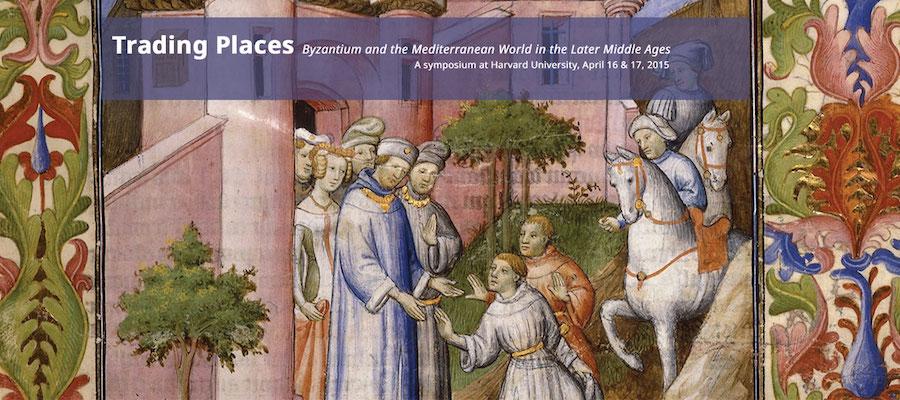Trading Places: Byzantium and the Mediterranean World in the Later Middle Ages

Trading Places: Byzantium and the Mediterranean World in the Later Middle Ages took place at Harvard University, April 16–17, 2015. The symposium was convened to explore the Mediterranean world as a “trading place” between Byzantine, Islamic, Jewish, and Western societies. It was supported by Dumbarton Oaks Research Library and Collection; European Commission, Research & Innovation, Marie Skłodowska-Curie Actions; Harvard Art Museums; Harvard University Department of History of Art + Architecture; Harvard University Provostial Fund for the Arts and Humanities; Harvard University Standing Committee on Medieval Studies; and Mary Jaharis Center for Byzantine Art and Culture.
The two-day symposium opened with a keynote lecture by the Cambridge University Professor of Mediterranean History, David Abulafia. In his lecture, “Problems of Periodization: The Mediterranean and Other Maritime Spaces in the Late Middle Ages,” Professor Abulafia argued that the period of 1350 to 1500 marked a new period in Mediterranean history, one in which the economy of the eastern Mediterranean was restructured and the political map of the region underwent significant transformations.
Three multidisciplinary panels addressed the economic, artistic, and material contours of medieval cultural exchange. A diverse group of scholars discussed fine ceramic ware production in Byzantium after the conquest of Constantinople (1204), Islamic illustrated manuscripts in late medieval Anatolia, cross-cultural oral and written interaction between Byzantium, the Islamic world, and the Latin West in the Middle Ages, Late Medieval Christian and Islamic coinage, the legal system of Venetian Crete, the legacy of Byzantine gold coinage in English royal ceremony, and digital approaches to the study of the Mediterranean world. The Very Rev. Dr. Joachim (John) Cotsonis (Director, Archbishop Iakovos Library, Hellenic College Holy Cross) and Dr. Eurydice Georganteli (Harvard University and University of Birmingham) led a medieval coins and seals workshop for symposium participants in the Art Study Center at the Harvard Art Museums.
The symposium concluded with Crossing Lines: Medieval Musical Encounters, a concert celebrating the shared musical culture of the Mediterranean basin. Holy Cross St. Romanos the Melodist Byzantine Choir began the evening with “The Joy of the Resurrection: Greek Orthodox Hymns of the Paschal Season.” Natasha Roule (vielle) and Ian Pomerantz (voice) followed the choir with interpretations of troubadour songs describing their encounters with Constantinople and the Holy Land. The performance featured excerpts of songs written by witnesses of the Third and Fourth Crusades. Voice of the Turtle ended the night with its program, “Jewels of the Mediterranean: Multicultural Experiences and Memories of the Past in the Music of the Sephardic Jewish Community of the Eastern Mediterranean,” a selection Sephardic ballads and other pieces illustrating the power of collective memory, communal experience, and story-telling in the Sephardic diaspora of the Eastern Mediterranean.